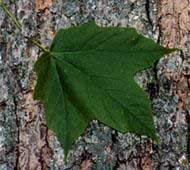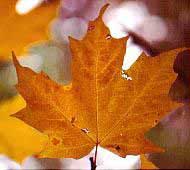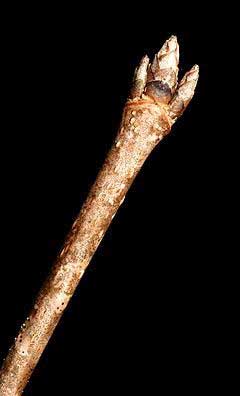Family: Sapindales
Most of the maples in The Woods are sugar maples, but if you look closely, there are also a few black maples. Black maples are found throughout northeastern North America. Black maples are found throughout Ohio and tend to grow in moist soils by streams. The species is occasionally planted as an ornamental tree. Mature trees range from 70 to 110 feet in height and two to three feet in diameter.

Figure 1. On the left, a Black Maple leaf and on the right, a Sugar Maple leaf. Pictures retrieved from http://www.oplin.org.tree/index.html
The leaves and buds of a Black Maple are opposite on the stems. Leaves are simple and are very similar to the leaves of a Sugar Maple (Figure 1). The key differences are that the Black Maple leaves are three-lobed and have drooping leaf edges. In comparison, a Sugar Maple generally has five-lobed leaves that do not droop.
Black Maple leaves are also wider with wider lobes and longer leaf stalks. Leaves are often 4 inches or more in length and dark green on the top surface and paler green on the bottom. Black Maple tree leaves in the fall range from yellow to orange-red in color.

Buds of a Black Maple tree are greyish black and small and pointed (Figure 2). Compared to the Sugar Maple, a Black Maple’s winter buds are often larger and have more hair. Twigs are brown and slender with small warty growths. Although they tend to be duller than the twigs of the Sugar Maple, older twigs will have a waxy coating.
The bark of a young Black Maple tree is dark grey in color, smooth, and firm. As the tree gets older, the bark becomes furrowed. The bark is similar to the Sugar Maple, but it is a bit darker with deeper grooves (Figure 3).
The flowers of a Black Maple are small and occur in clusters with each flower at the end of a long dangling flower stalk (Figure 4). Drooping clusters are 1 to 3 inches long. The flowers bloom in late winter to early spring and are green-yellow in color. In general, the flowers are almost identical to those of the Sugar Maple. Male and female flowers can occur on the same tree.
Also, like the Sugar Maple, Black Maple trees produce paired samara which are winged fruits (Figure 5). These fruits hang in short clusters. The Black Maple fruit has a slightly larger seed than a Sugar Maple.
Like the Sugar Maple, the Black Maple is one of the most popular tree species used for the production of maple syrup because of its high sugar content. The Black Maple, like the Sugar Maple, is also valuable for its timber. It has been
commonly used in the production of furniture, flooring, musical instruments, baseball bats,
paper, and much more. Animals commonly browse Black Maple trees and feed on the buds, seeds, and leaves. Songbirds, small mammals, and other cavity dwellers frequently live in Black Maple trees.
References:
Cornell Sugar Maple Research & Extension Program. (n.d.). Black Maple. Retrieved from Cornell University Website:
http://maple.dnr.cornell.edu/kids/tree_blk.htm
OPLIN. (1997). Black Maple. Retrieved from the Ohio Public Library Information Network Website: http://www.oplin.org/tree/fact%20pages/maple_black/maple_black.html
Additional References:


